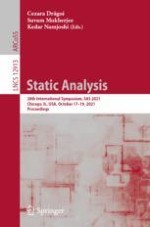This book constitutes the refereed proceedings of the 28th International Symposium on Static Analysis, SAS 2021, held in Chicago, IL, USA, in October 2021.
The 18 regular and 4 short papers, carefully reviewed and selected from 48 submissions, are presented in this book together with 1-page summaries of the three invited talks. The papers cover topics such as static program analysis, abstract domain, abstract interpretation, automated deduction, debugging techniques, deductive methods, model checking, data science, program optimizations and transformations, program synthesis, program verification, and security analysis.
